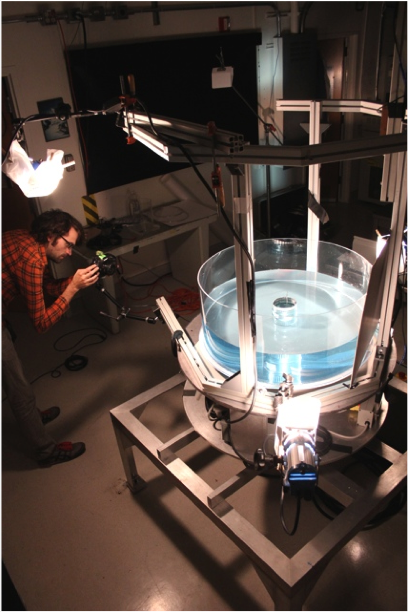By Jonathan Aurnou & John Cantwell

Spend a day at the ocean or just stop to watch the clouds: there’s ample evidence that the fluid systems around you—the oceans and the atmosphere—are in constant motion. These enormous systems are not only moving and constantly changing, but they’re also capable of undergoing dramatic fluctuations—like hurricanes—that can have profound consequences in our world.
In addition, we also know that human lifestyle is having an impact on the oceans and the atmosphere. From extensive fishing to massive production of carbon dioxide, we are causing significant changes to these systems.
Because we depend on the atmosphere and the oceans—and because we’re becoming increasingly aware of our impact upon them—it’s important to understand how these systems function. At UCLA, we teach a course called “Blue Planet: An introduction to Oceanography.” One of the topics discussed in this course is the large scale fluid dynamics occurring in the oceans and atmosphere. We can create simplified laboratory models of these fluid motions. With funding from UCLA and the National Science Foundation, we devised several small-scale lab experiments and have created a 30 minute film to demonstrate basic fluid motions similar to those occurring in atmospheres and oceans.
In these small-scale experiments, we use water to simulate the fluid dynamics of both the liquid (oceans) and gaseous (atmospheric) envelopes. To simulate the spinning of the earth, we carry out our experiments on a rotating table we have in our lab at UCLA. When we talk about rotating systems—like the earth and most other bodies in the universe—we talk about the Coriolis acceleration. This refers to the way rotation causes a deflection of any moving body, a solid or a liquid, observed within the rotating frame. For each experiment, we begin by looking at our system first without the effects of rotation. Then, we include rotation to see how the behavior of the fluid changes due to the Coriolis accelerations. What you’ll see at the end of this series of experiments is how a planet’s rotation fundamentally influences the large-scale fluid motions of its oceans and atmosphere.

First, we will look at the Coriolis effect with a solid (Chapter 1)—in this case, a ball bearing. Then, we will explore analogs to large-scale atmospheric motions, the atmospheric circulation and the associated wind-belts (Chapter 2, Chapter 3, Chapter 4). Using our model of the wind-belts, we will carry out experiments to understand why large patches of floating garbage are forming near the centers of earth’s ocean basins (Chapter 5). Then, we will carry out experiments with packets of creamer that demonstrate how rapidly rotating fluids behave somewhat like a fluid gyroscope (Chapter 6). Finally, we will carry out experiments to show how swirling motions, called vortices, differ in non-rotating (Chapter 7) and strongly rotating systems (Chapter 8). These last experiments will help us understand the kinds of images we’re now seeing from telescopes and space missions, showing planetary atmospheres in motion.
Our hope is that by viewing these experiments you will develop a sense for how fluids behave both in rotating and non-rotating systems. By noting the differences between the experiments, it should be possible to establish a basis to think about large-scale fluid motions that exist in Earth’s oceans and atmospheres as well as on planets other than Earth.
Videos:
The following videos were filmed in the SPINLab in UCLA’s Department of Earth and Space Sciences. To download movies right click on the download link and select “Save link as”.
Full version
“The Full Monty” (30 min.):
Contains the entire compiled set of experiments, including in-depth explanations of our results and how they relate to geophysical observations.
Chapters
The video clips below contain short segments that highlight individual experiments:
Coriolis Effect (2m12s.)
Download (.mp4, 23 MB)
Atmospheric Circulation, Stationary and Rotating Channel Experiments (1m19s)
Download (.mp4, 20 MB)
Effects of Rotation on a Creamer Plume
Models of Geophysical Vortices, Stationary Experiment (1m56s)
Download (.mp4, 20 MB)
Models of Geophysical Vortices, Rotating Experiment (3m47s)
Download (.mp4, 40 MB)
Project Personnel:
Experiments: Jonathan Aurnou & John Cantwell
Cinematography & Editing: Jon Schwarz & Gabriel Noguez
Consultants: Shawn Adams, Nick Miramontes, Michael Calkins, Kate Ledger, Jonathan Mitchell, Kunio Sayanagi
Funding: NSF’s Geophysics Program & UCLA’s Office of Instructional Development

